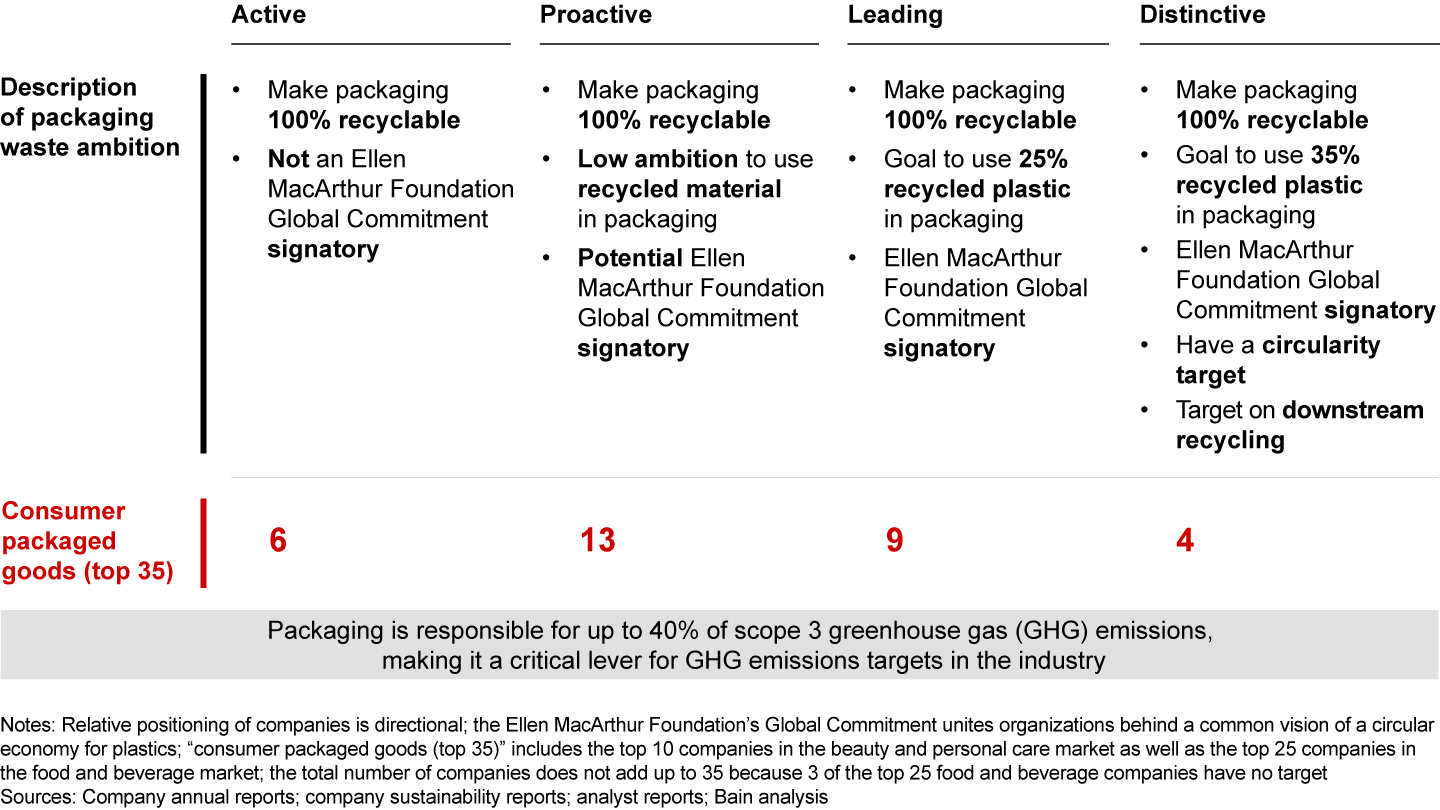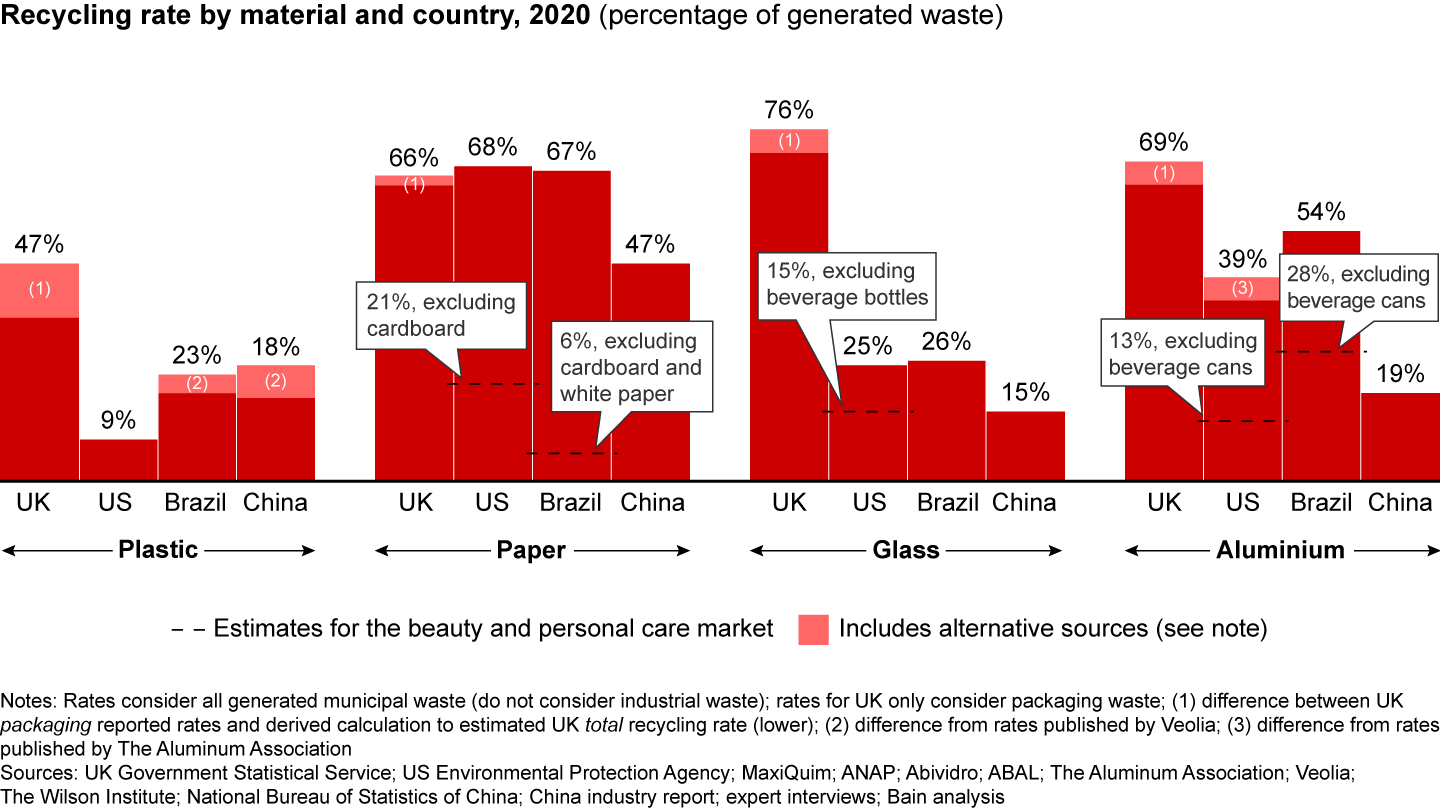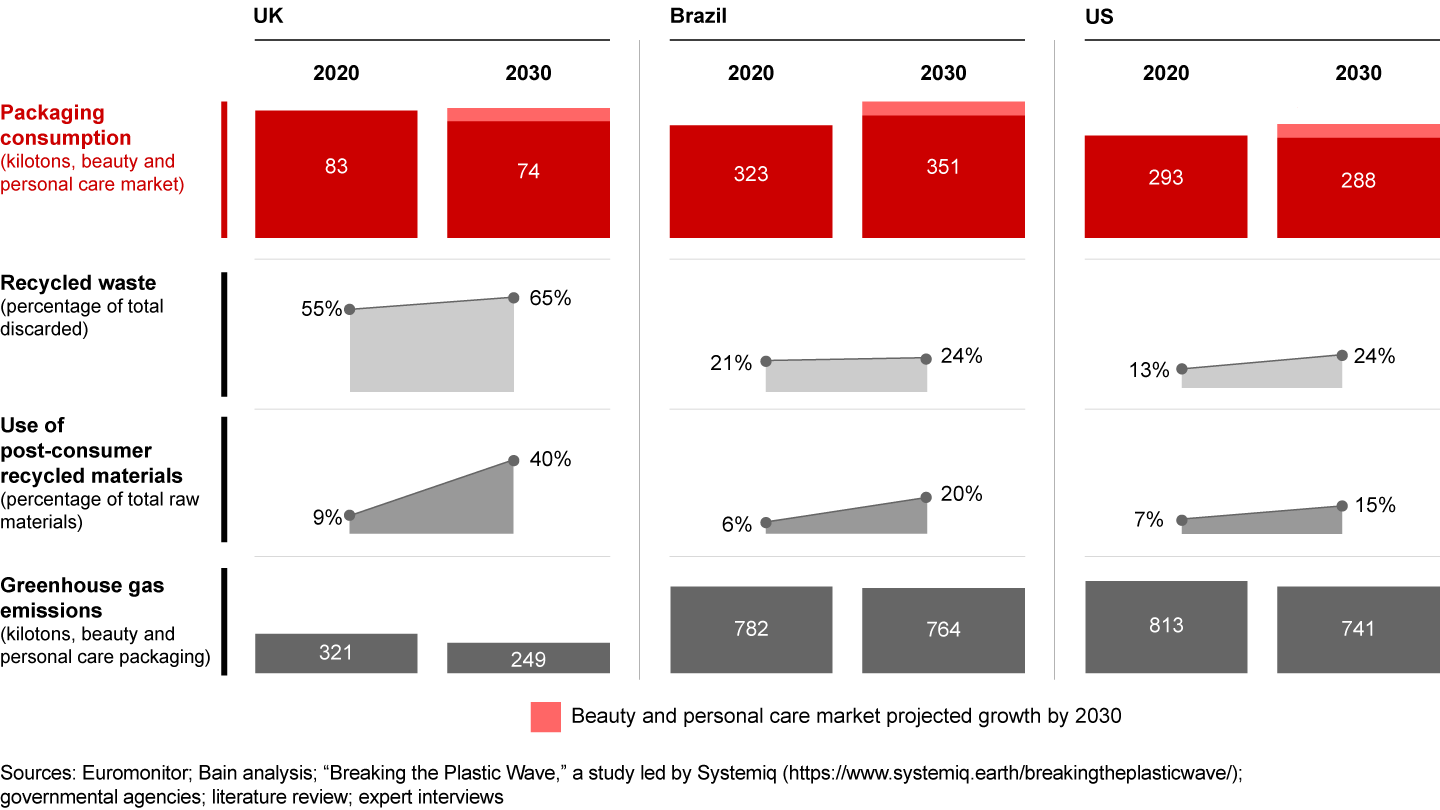Etude

En Bref
- Most of the major fast-moving consumer goods companies have targeted packaging transformation to achieve circularity targets while reducing greenhouse gases (GHG) emissions.
- Consumer goods companies that make the biggest strides will start by focusing on legislation, infrastructure, consumers and retailers, and technology, enabling them to better understand available solutions and direct their efforts accordingly.
- The approach helped one global beauty company pinpoint ways to reduce packaging GHG emissions by more than 40% in 2030 by using 20% less packaging material (among other moves).
The environmental challenge of packaging waste has exploded, with governments, regulators, consumers, shareholders, employees, and society at large putting immense pressure on brands that use packaging and other single-use items to address the unintended consequences of the current linear packaging system. Going forward, we expect to see an acceleration of pressure on packaged goods companies. In parallel, reuse and refill may be legally mandated (as we are starting to see in France and other markets), standardized packaging may become the norm, and certain polymers/additives/pigments may be banned.
In this context, many fast-moving consumer good companies are reimagining packaging to achieve circularity targets while reducing greenhouse gases (GHG) emissions. But they face some big hurdles. Even when they invest in innovations for recyclable packaging, for example, companies often find themselves at the mercy of inadequate recycling and waste management systems in the markets where they make and sell goods. In addition to dealing with broad variations in infrastructure and legislation in different countries, companies must plot their packaging roadmap amid the uncertain path of technology advances in everything from materials to recycling as well as unpredictable consumer acceptance of different solutions, especially new business models. And success requires thoughtful coordination and cooperation with multiple stakeholders across the system, including suppliers, retailers, industry groups, and governments.
With these and other obstacles in front of them, companies are stymied by how to make progress in their sustainability journeys.
It’s a huge deal and getting bigger. Today, 45% of the world’s emissions come from making products and consuming them, and all top 10 plastic polluter companies in the world are in the consumer products industry. In addition to lowering the emissions generated by manufacturing, packaging changes can deliver up to a 30% reduction in scope 3 emissions. The stakes keep rising as consumer goods companies target growth in the developing markets that represent the lion’s share of unmanaged waste.
Given the critical role they can play, most large consumer goods companies have made big commitments to packaging innovation and other means of reducing emissions, falling into different categories based on their ambition (see Figure 1). But major sustainability transformations are difficult to achieve. According to our research, only 7% of companies succeed—half the rate of other transformations. Another disappointing finding: 80% of companies that started less than a year ago report that their sustainability program is not on track.

Consumer goods companies that make the biggest strides toward packaging circularity will invest to understand the trajectory of four fundamentals at play:
- legislation;
- infrastructure;
- consumers and the retailers that sell a consumer products company’s goods; and
- technology.
We refer to them collectively as LICT (see Figure 2). That analysis helps companies prioritize the appropriate levers to pull so that they can achieve their packaging circularity goals, choosing from the four R’s:
- reduce (e.g., with concentrated products),
- reuse (e.g., at-home and in-store refills),
- replace (e.g., post-consumer recycled, PCR, materials),
- recycle (e.g., products designed to recycle)
Mapping trends in the LICT fundamentals also enables companies to clearly see the trade-offs they will need to make as well as the best way to mobilize stakeholders to deliver on the plan.

This approach has set the stage for a global beauty company to establish priorities and identify what to expect from each of the four R’s across all its markets. The company ultimately pinpointed ways of reducing packaging GHG emissions by more than 40% in 2030 vs. its 2020 emissions by using 20% less packaging material, delivering products in which half of the plastic ingredients are recycled, and by making 100% of all packaging ingredients either reusable, recyclable, or compostable.
Four foundations, four questions
Companies hoping to pursue similarly bold goals need to ask basic questions for each element of LICT to understand their starting point as well as the potential impact on the industry.
How is legislation evolving? Waste legislation can happen in the form of bans (e.g., single-use plastics); mandatory targets (e.g., recycling rate, minimum required PCR content); taxes and fees (e.g., extended producer responsibility, EPR, fees paid by the polluter); and standards and compliance (e.g., deposit return scheme, labeling). Although these mechanisms are similar globally, countries are in widely different stages of waste legislation evolution. In general, the EU is furthest along, but China and a few pioneering US states are starting to implement a robust agenda, significantly increasing recycling rates through EPR mechanisms by material and select deposit return schemes, for example.
Consider the situation in four key markets for consumer goods. The UK’s favorable environment and ambitious targets should help many companies achieve their goals. For example, companies can avoid the £200-per-ton plastic tax if their packaging has 30% or more PCR content; it’s a move that is spurring the recycled content market. On the other hand, Brazil’s legislation and infrastructure challenges are likely to persist, and cross-industry mobilization may be needed to help local companies achieve circularity goals. In the US, different conditions across different states can require the industry to take the lead in nationwide strategies. While China’s current situation presents challenges in the near term, the government focus ultimately is likely to support great advances for company efforts.
What are the infrastructure requirements? Having identified the legislative environment in their major markets, companies need to look at infrastructure. The waste management infrastructure for packaged goods spans manufacturing, post-consumption discarding, collecting/sorting, and recycling/disposing. Infrastructure, as well as recycling rates, varies by material and by country (see Figure 3). For example, the UK and EU have achieved high rates of formal collection, sorting, and recycling for most important materials. By contrast, Brazil and China have low rates of formal collection and sorting. While the US has high rates of formal collection, its recycling rate is low, even for important materials such as polypropylene (typically present on covers and in some tubes) and polyethylene/polyethylene terephthalate plastics (typically present in bottles). While the UK and US waste management systems are consolidated into large companies, recycling in Brazil and China is made possible by several small and mostly informal participants. A deep understanding of how the waste management system deals with discarded packaging materials is key to informing product innovation and generating a positive impact.

How is consumer behavior changing, and how are retailers responding? Consumer goods companies need to clearly understand the role that consumers and retailers play in accepting and leading changes. Consumers are increasingly aware of sustainability challenges and say they are more willing to act. Climate change, air pollution, and waste are the top-of-mind sustainability concerns globally, and avoiding excessive packaging is the action that consumers are most willing to take. There are, however, important issues that prevent consumer behavioral change. Although awareness is increasing, many consumers still are confused about sustainability—that is, what makes a product sustainable and what to do. Consumers aren’t fully confident in their ability to change their behavior or make an impact.
There’s also the convenience factor; adopting more sustainable practices requires greater effort from consumers. There still is a gap between consumers’ expectations and available sustainable options. Finally, while consumers say they would pay a premium for sustainable products and brands, some perceive them as being too expensive. Different segments of consumers tend to engage at different levels—for instance, about 40% of consumers already report caring about the planet in the EU and US. But in general, for consumer goods companies to deliver on circularity targets, more consumers will need to make trade-offs by trying new packaging presentations or sensory experiences—everything from concentrated solutions in cleaning, for example, to powders and solid bars in toiletries. They’ll also need to participate in waste sorting and reverse logistics programs. Today, only 14% of EU consumers and 8% of US consumers claim environmental, social, and corporate governance (ESG) issues as purchase criteria.
Meanwhile, even though the retailers that sell consumer products are at different stages of maturity, their overall level of ESG engagement is increasing. Our study across 40 global retailers found that nearly three-quarters of them included a sustainability pillar in their corporate strategy. They are setting science-based targets for reducing their emissions or becoming Ellen MacArthur Foundation Global Commitment signatories for circularity. The immediate implication for the consumer products industry is that retailers will change what they find acceptable in packaging ingredients and will redefine shelf space allocation.
What are the technology breakthroughs? Technological innovations are being developed to minimize waste generation and to improve decarbonization and the management of unavoidable waste; GHG-capturing technologies are also in the works. Since 2018, private equity and venture capital firms invested more than $6 billion in recycling facilities and bio-based packaging alone. Recycling and substitution with recycled glass, metal, and paper are the solutions with the highest probability of scaling by 2030. To achieve their 2030 targets, companies shouldn’t count on chemical recycling or industrial composting, given that both technologies won't be available on a large scale by the end of this decade. On the other hand, mechanical recycling will get more effective and still should be the dominant technology by 2030.
Planning for different scenarios
While packaged goods companies want to take meaningful action, the economic, environmental, and social implications of different solutions are often uncertain, and the industry still needs guidance regarding what actions to prioritize in diverse geographies/applications as well as how to find synergies among various solutions.
Based on this LICT assessment, three plausible scenarios emerge for what consumer goods sustainable packaging could look like in 2030 across the US, UK/EU, China, and Brazil markets:
- a substitute economy in which advances in consumer behavior will lead to a shift toward alternative materials and new product presentation (in this scenario, companies should not rely too heavily on recycling);
- a circularity breakthrough brought on by advances mainly in legislation, infrastructure, and technology, leading to recycling industry development; and
- a green shift in which advances in all four LICT elements reduce material demand and reshape the value chain to a circular flow.
Each market’s situation and unique LICT trends will determine its most likely scenario. For example, in the UK, a strong push for recycling in the coming years, combined with incentives and a build-out of infrastructure capacity, likely will advance the market toward a green shift. By comparison, Brazil could move toward a substitute economy based on likely poor waste management infrastructure and an unclear 2030 legislation outlook. There, most relevant changes will be mostly driven by consumer behavior and retailers’ practices. In this context, companies’ product innovation will be critical to promote circularity.
The situation in the US likely will be more complex. Pioneering states with a robust infrastructure and legislative agenda can advance toward a green shift; in other states, a possible shift to a substitute economy will depend in large part on changes in consumer behavior encouraged by nationwide companies. Understanding these potential scenarios helps companies decide on the right circularity agenda and how to engage other stakeholders.
When a global beauty and personal care company went through this process, it was able to clearly determine the impact of different actions by evaluating the weight of materials produced, the potential to be truly recycled, reused, or composted, and the GHG emissions per ton produced (see Figure 4). Because those factors don’t always move in the same direction, the company needed an integrated view, and it acknowledged that some trade-offs would be required. It considered the feasibility of different initiatives given specific constraints. For example, the company could make great strides with innovation in refill packaging and concentrated product formulations, both of which involve minor technological challenges but major consumer behavioral shift requirements. Designing for recycling would be harder from a technology perspective.

The company decided that it could achieve greater impact in the short term by reducing material weight and by reducing or eliminating some plastic. Using compostable materials and biopolymers and developing on-premise refill or returnable options would take longer because of technological and waste infrastructure challenges, but those initiatives could transform the industry in the medium term. Meanwhile, working on alliances and coalitions to contribute to the development of infrastructure and technology, encourage consumer behavioral change, and support waste legislation would require coordination outside the organization, but doing so could help advance the sustainability agenda both within and beyond the company.
Armed with these insights, the beauty company created a clear roadmap for a more than 40% reduction in GHG emissions through packaging changes. The quantitative approach helped the company identify the key moves to make.
To achieve its goal, the company also needed to mobilize the organization and promote leadership alignment around priorities.
Circular packaging transformation: A top management collective agenda
What could this look like at a large consumer goods company? Sustainable packaging transformation is a complex agenda. As with any other strategic transformation, top management engagement is critical to set the priorities, allocate resources, promote behavioral change, and engage all stakeholders in the journey. More precisely, each top management leader will play a critical role to drive this change.
The CEO could make public comments and mobilize the organization while also committing company resources to ESG initiatives. The chief marketing officer could focus on overcoming consumer barriers and generating desire for sustainable products. Category managers could be tasked with translating product innovation projects that align consumer needs with the company’s sustainability goals.
The chief procurement officer should go after sourcing the new materials and ingredients needed, and the chief supply chain officer should revisit the supply chain and make the adjustments required to adopt new packaging materials and formulas.
Meanwhile, the chief sustainability officer could support all areas based on a quantitative approach with an integrated view and a clear roadmap. The R&D head could allocate the appropriate resources, respecting mandatory moves while also betting on future (and more disruptive) solutions. Teams could focus on developing a reverse logistics program as well as supplier engagement on product innovation, and they could create alliances within the industry, forging relationships with key stakeholders.
Forward-looking companies that build the capabilities and flexibility to navigate the complex packaging challenge are likely to emerge as winners. Success means starting early and taking some calculated risks. The best companies will identify options to shift toward favorable packaging materials, and they will gain control of after-use packaging materials and the supply of recycled materials through vertical integration or strategic collaborations with the full waste value chain. Brands that fully embrace circular economy principles can connect with their consumers in new ways and create new value pools around different sensory experiences (better design, better materials) and better delivery models.
Consumer goods executives see the opportunity to transform packaging as a way of advancing toward their circularity targets while reducing emissions. They acknowledge that there’s much on the line and much ground to cover quickly. Yet, as they plot their path amid an aggressive timetable and obstacles that seem daunting, those that take a systematic approach will make the biggest leaps toward their sustainable future.



